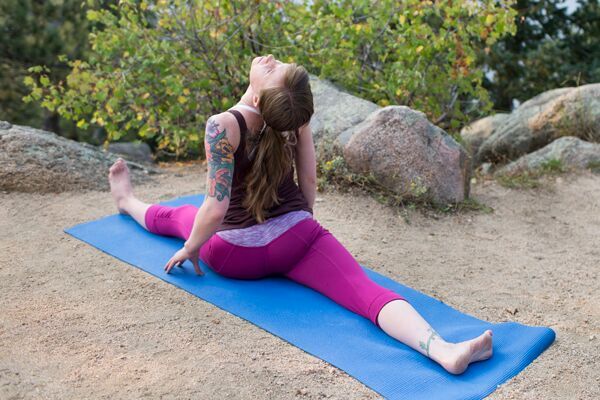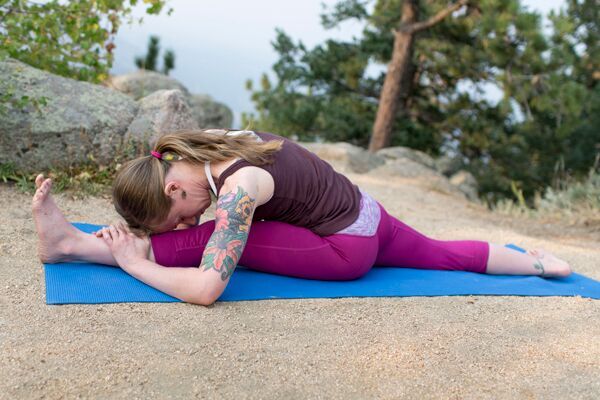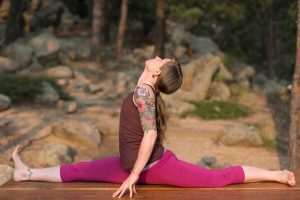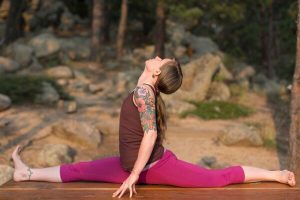 In honor of this year’s Hanuman Jayanti (aka Hanuman’s birthday) on this full moon day of April 22nd, I felt it quite fitting to have this month’s Yoga pose be Hanumanasana, the very pose that is named after the lovable Monkey God. Hanuman represents courage, strength and devotion which are the very qualities this posture offers to one that practices it on a regular basis. Hanuman, as the son of Vayu (wind), was known for his giant leaps using his back leg to propel the jump, and the other leg stretched to the front to guide the way. Hanumanasana or the front splits, is an advanced posture that needs to be practiced in a modified version, until the openness of the shoulders, hips, lower back and hamstrings come with ease. This can be acquired with patience and consistent practice, along with utilizing other postures to open these areas of the body.
In honor of this year’s Hanuman Jayanti (aka Hanuman’s birthday) on this full moon day of April 22nd, I felt it quite fitting to have this month’s Yoga pose be Hanumanasana, the very pose that is named after the lovable Monkey God. Hanuman represents courage, strength and devotion which are the very qualities this posture offers to one that practices it on a regular basis. Hanuman, as the son of Vayu (wind), was known for his giant leaps using his back leg to propel the jump, and the other leg stretched to the front to guide the way. Hanumanasana or the front splits, is an advanced posture that needs to be practiced in a modified version, until the openness of the shoulders, hips, lower back and hamstrings come with ease. This can be acquired with patience and consistent practice, along with utilizing other postures to open these areas of the body.
Hanumanasana is a grounding pose that is useful to reduce Vata or excessive wind in the body and mind. It massages and encourages blood flow to the pelvic region including the groin, the reproductive organs, the colon and the lower back. Hanumanasana, being a Vata-reducing posture, also helps to relieve gas, bloating, constipation and sciatica. It is said to improve flexibility and tone the legs, especially the hamstrings and the outer thigh muscles (aka abductors). Even though the main area of stretching lies in the legs and hip region, the shoulders also must learn to relax and open in order to come into this posture with ease.
If you are just beginning to practice this posture, it is recommended to begin with a modified and supported version. One can place bolsters or folded blankets under the pelvic floor, while placing blocks on each side of the body to allow proper support by the hands. I would also suggest to practice this posture along with similar postures that open these vital areas on a daily basis, in order to really make strides in obtaining the full posture.
Of course you should always practice full awareness and honesty when coming into these advanced asanas, and only go to your ability that day (and yes, it changes daily). If you are not honest with yourself and overstretch or pull a muscle, this will not only impede you to accomplish this posture, it will also set you way back from any strides you had already made, as the hamstrings and adductors are not quick muscles to heal. Ultimately, especially for beginners, it is always best to learn directly from a knowledgeable teacher in order to avoid injury, while ensuring proper preliminary sequencing and allignment.
As a side, personal note, I acquired this posture not because I am naturally flexible, but rather because I practiced this posture with my teacher on a daily basis for several years before obtaining the full pose. To this day, Hanumanasana continues to be an essential part of my morning Yoga practice. If you are discouraged because you feel you have been doomed to be inflexible, please know that when I took my first Yoga class at the age of 19, I could not even touch my toes; and although I tried many times as a kid, I never once came into a full split until I was about 26. So if you are determined to conquer this posture, practice daily with a knowledgeable teacher, use awareness, invite patience and I guarantee you will notice great strides and improvement overtime.
Hanumanasana
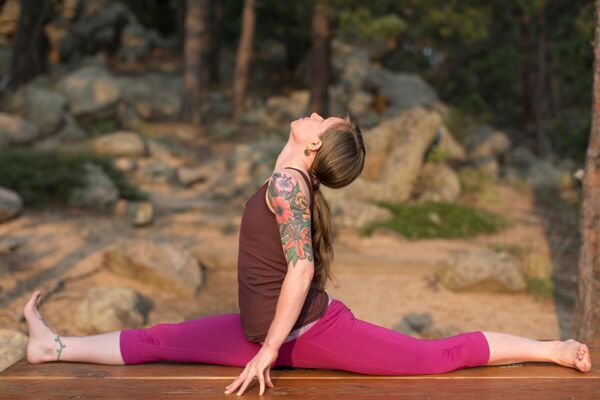
- Doshic Qualities: Vata ↓,Pitta =, Kapha =
- Best Season for Practice: Beneficial in all seasons, especially Fall and early Winter
- Elemental Component: Grounds Air and Space, promotes and nourishes Earth and Water
- Main Areas of Healing in the Body: Pelvic region, hips, legs (especially outer thighs and hamstrings), lower back, shoulders
- Main Organs and Systems: Colon and reproductive organs
Health Benefits of Hanumanasana
- Promotes grounding and stability
- Reduces Vata imbalance
- Relieves gas, bloating and constipation
- Releases emotions and tension being held in the hips, legs and pelvic region
- Beneficial in sciatica, although should be eased into the posture with caution!
- Nourishes reproductive organs
- Opens and relaxes the shoulders
- Awakens Muladhara Cakra (root chakra)
- Increases flexibility in the leg muscles
- Tones the legs
- Beneficial posture for runners
- Promotes courage, strength and devotion
Contraindications
- Hamstring or groin injury
- Lower back pain (perform with caution)
Preliminary postures to open the hips and hamstrings:
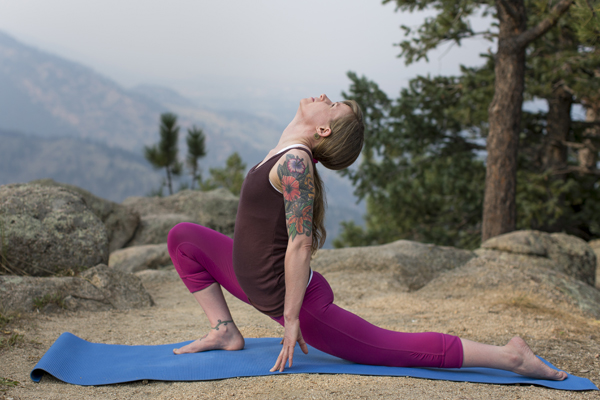
Ardha Bujanga (half cobra; low lunge)
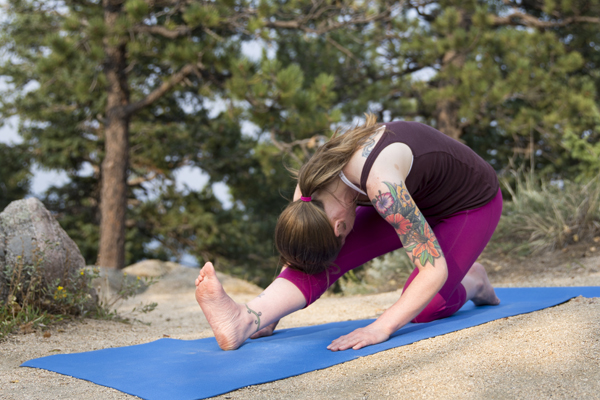
Ardha (half) Hanumanasana
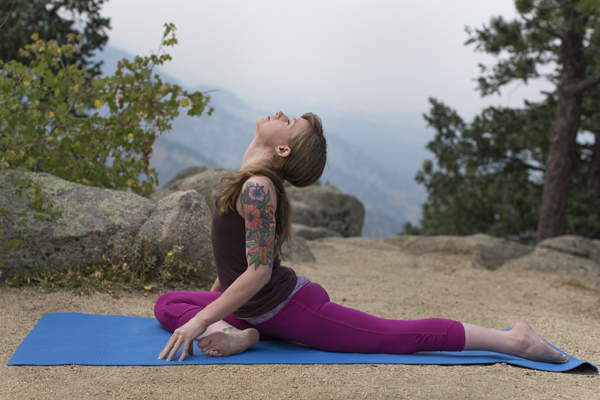
Kapotasana (pigeon pose)
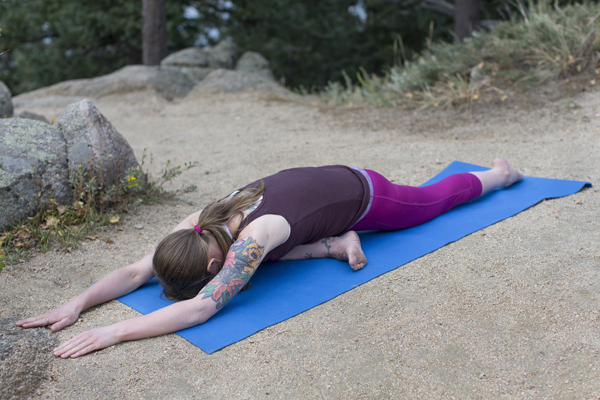
Kapotasana (pigeon pose), folded forward
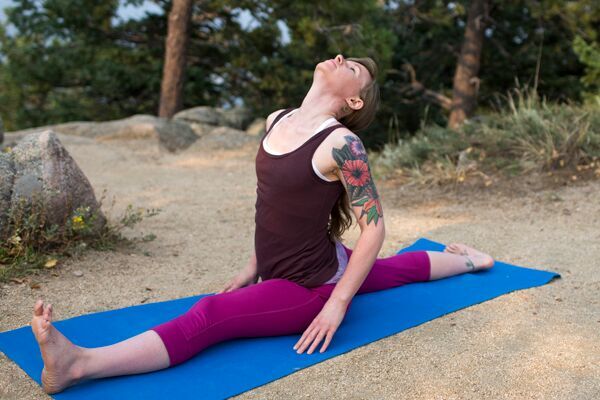
Hanumanasana, full posture
Step-by-Step Instructions for Hanumanasana
- Kneel on the floor with both knees.
- Place the palms to the floor on each respective side of the body.
- Begin to stretch the left leg to the front and the right leg to the back, keeping full support with the hands. This can be done on an exhale.
- The front, left foot is pointed straight, while the back, right foot lies on the arch, toes pointed to the right. This is one version of this pose. For an alternate version, the front foot stays the same, but the back foot rests on the dorsal (top) surface of the foot, toes pointed straight back.
- Take note of the shoulders and release any tension or constriction in this area. The shoulders are distally related to the hips, and therefore releasing tension in the shoulders is essential for opening the hips.
- Slowly continue to straighten the legs as the pelvic area sinks to the floor. Once again the hands are being used to support most of the weight as you ease cautiously into the posture.
- Once the legs are fully straight and the pelvis sits on the floor, the hands can rest on the finger tips beside the body; or alternatively the palms can be placed together at heart center. The weight is completely on the legs and the pelvic region in the full pose.
- Stay in this position for 10 slow and steady breaths through the nose.
- Once you are ready, place the palms flat to the floor, lift the hips and switch the legs so the right leg is in front and the left leg back. Stay in for 10 steady breaths.
- If the full pose is not happening to begin, make sure to practice this posture daily, along with similar postures to open up the hips, hamstrings, lower back and shoulders (see some options above).
- Use props if needed, as you train the body to open up to the posture.
